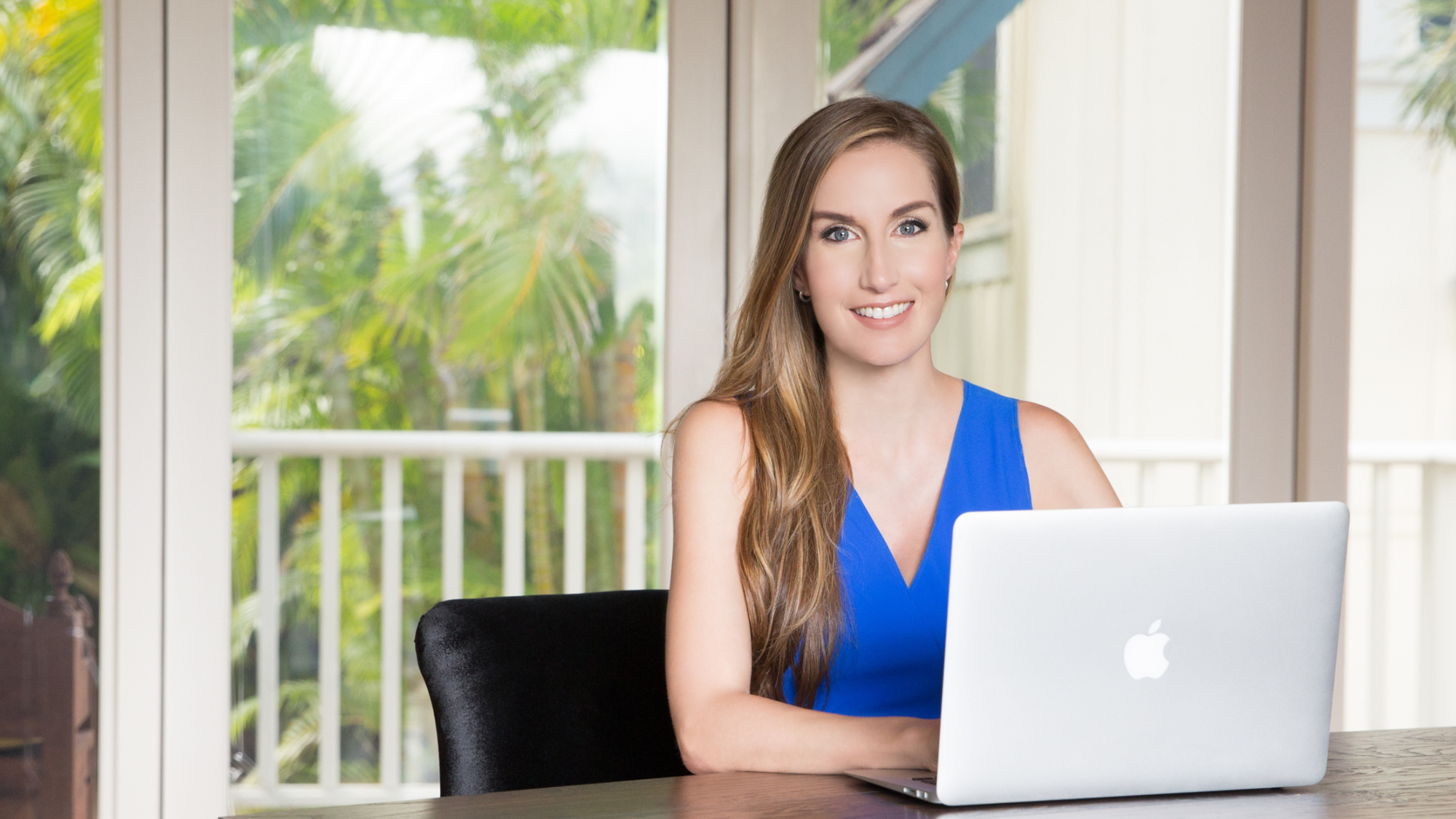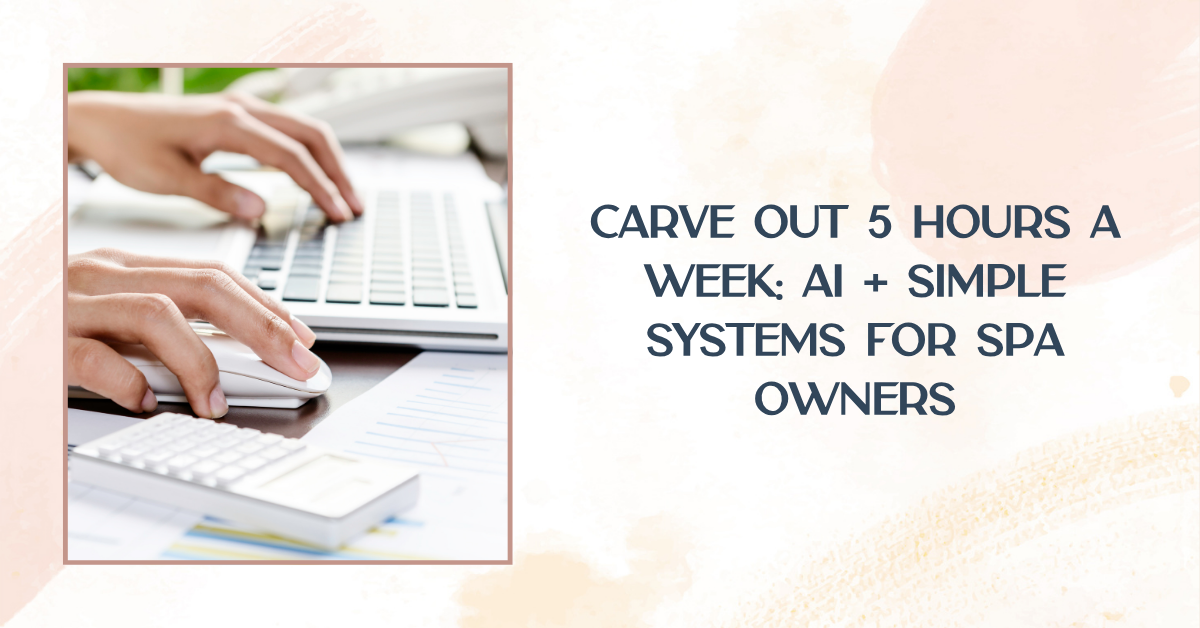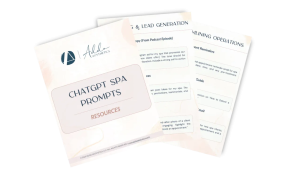What would your business look like if you had five extra hours fully dedicated to working on the business, not in it? No inbox fires. No late client texts. No scrambling between treatments and interviews. Just clear space to think strategically, build systems, and lead.
If that sounds impossible, stay with me. It’s closer than you think. In this guide, we’ll turn that idea into an actionable plan you can follow to claim real CEO time, use AI to buy back hours, and make your growth predictable and repeatable.

Most spa owners start as expert providers and end up juggling all the roles—provider, receptionist, HR, marketing, and more. That scrappy hustle works in the early days, but eventually it becomes the bottleneck. CEO time is the dedicated space you use to:
- Set and refine the vision
- Build systems and standard operating procedures (SOPs)
- Clarify strategy and prioritize initiatives
- Shape team culture and brand standards
This is where scale starts. When you consistently protect this time, you stop being the do‑it‑all technician and step into Spa CEO leadership—even if you’re a solo owner right now.
The payoff is massive: better decisions, calmer operations, and a business that grows without burning you out.

Below is a practical, four‑part plan to win back your week and make CEO time non‑negotiable.
1.) Audit your workload and find your first 5 hours
Start with a simple two‑column list:
- Column A: Everything you do in a typical week (treatments, admin, marketing, team, errands)
- Column B: What can be automated, delegated, or templatized this month?
Look for quick wins—recurring replies, appointment reminders, new client onboarding, and front desk scripts. These can be templatized or automated fast (keep reading for plug‑and‑play prompt ideas).
Goal for Week 1: Reclaim at least five hours by removing or automating low‑value tasks. If five feels like a stretch, start with one hour and build momentum.
2.) Design an ideal week that reduces context switching
Context switching—jumping between providing treatments and doing CEO tasks—kills productivity. Wherever possible, batch your days so you can stay in one mode at a time.
- Provider Days: All client‑facing work (treatments, consultations)
- CEO Days: No clients. Full focus on strategy, systems, hiring, marketing, KPIs.
Can’t swing full CEO days yet? Block two 90‑minute CEO blocks per week to start, then expand. Protect them like your most profitable appointment.

3.) Protect the time with systems and boundaries
Your CEO time won’t survive without guardrails. Put these in place:
- Booking rules that make CEO blocks unavailable to clients
- Phone/text policy (e.g., “We reply during business hours only”) and canned replies
- A client communication cadence (e.g., all post‑care texts answered at 11am & 4pm)
- A weekly team check‑in so small issues don’t bleed into your focus time
- Front desk scripts and FAQs so the team can answer before it ever hits you
4.) Know exactly what to do during CEO time
CEO time isn’t for “catching up.” It’s for building a business that runs on systems. Rotate these focus areas:
- Systems & SOPs: Intake, post‑care, retail flow, membership fulfillment, inventory, payroll
- Team: Scorecards, hiring pipeline, onboarding, performance reviews, training guide
- Money: Pricing, KPI dashboards, cash flow, expense audit, profit plan
- Marketing: 90‑day content calendar, email nurture, social proof, event playbook
- Vision & culture: Brand standards, client experience, values in action
Pro tip: Pick one operating system to finish each week (e.g., “Finalize membership SOP + training video”). Momentum beats perfection.
Whether you love technology or prefer pen‑and‑paper, AI is now a practical way to reclaim hours without hiring. Think of it as a tireless assistant that can draft, organize, and even improve your work—as long as you give it clear direction.
Here are straightforward ways to use tools like ChatGPT in a spa business this month:
1. Client policies – Late cancellations, no‑shows, deposits, refunds
2. Front desk scripts – Phone, text, voicemail, pricing questions, pre‑/post‑care
3. Onboarding packets – New hire checklist, role scorecards, 30‑60‑90 day plan
4. SOPs – Intake flow, membership fulfillment, inventory counts, room turnover
5. Job descriptions – Provider, front desk, manager, social media assistant
6. Performance reviews – Quarterly templates aligned to KPIs
7. Team training – Protocol summaries, case studies, standards checklists
8. Marketing content – Blog posts, email sequences, social captions in brand voice
9. Weekly planning – Ideal week, calendar blocks, meeting agendas
10. Automated follow‑ups – Post‑consultation, retail reorders, reactivation emails
Treat your AI setup like a team member: invest a bit of time to “train” it on your brand voice and standards, and it will return hours every week.
How we use AI at Addo (and what you can copy)

At Addo Aesthetics, I record our podcasts as usual (I’m a speak‑to‑thinker!), then we upload the transcript into a custom GPT we’ve trained inside ChatGPT (hundreds of episode transcripts, brand voice notes, offers, and messaging). From there, the assistant produces:
- Multi‑format show notes (short + long)
- Email promos and social captions
- Blog drafts in our voice
- Episode graphics copy (headlines, hooks, alt text)
The result? Tasks that used to require a few hundred dollars and up to a week are now handled in minutes—for a fraction of the cost.
Two keys make this work:
- Inputs matter. The better your SOPs, examples, and prompts, the better the output.
- Humans still lead. Strategy and quality control come from you; AI accelerates the doing.
You can replicate this—even as a solo owner—by storing your best content (emails, posts, policies, offers) in a single folder and using it to “prime” your AI assistant before giving it tasks.
Common speed bumps for CEOs—and how to handle them
- “I don’t have time to plan.” Start with one saved hour. Use it to remove the next bottleneck. Compounding wins are the goal.
- “My clients expect instant replies.” Set clear response windows and use friendly canned templates. Most clients respect boundaries when you explain the why.
- “I feel guilty stepping away from the room.” Your clients benefit more from a business that runs smoothly. CEO time creates better service and outcomes.
- “I’m not techy.” You don’t have to be. Start with policies, scripts, and email templates. Keep a simple swipe folder and reuse.
- “I need everything perfect.” Ship version 1.0. Improve monthly.
What to work on first inside CEO time

Start by revisiting your Column A/Column B audit from Step 1. Ask: Do any of your biggest time-drainers or quick wins fall into the categories below? This is not a step-by-step order—choose what your spa needs most right now. Circle the one or two categories that will remove the most friction or create the most ROI, and ship one operating asset this week.
- Policies & scripts → stabilize client communication
- Memberships & retention → recurring revenue, predictable cash flow
- Hiring pipeline → job description, interview scorecard, onboarding plan
- KPI dashboard → weekly numbers that drive decisions
- Client experience SOPs → intake → service → retail → rebooking → follow-up
- 90-day marketing plan → educational posts, proof, email nurture, offers
The bottom line
Creating Spa CEO time isn’t a luxury—it’s a system. Start with a single protected hour, use AI to clear the busywork, and build one operating asset every week. Do that for a quarter and you’ll feel the compounding effect: less chaos, better margins, and a calmer, more scalable business.

Subscribe to Our Newsletter
Stay up-to-date with our email newsletter to receive important updates, news, and offers!

About the Author
Daniela Woerner is the founder of Addo Aesthetics and creator of the Growth Factor® Framework, a proven system that’s helped hundreds of spa owners build profitable, systemized businesses. With nearly 20 years in the aesthetics industry, she transforms overworked aesthetic professionals into confident Spa CEOs through strategy, systems, and soul-led support. Daniela is also the host of Spa Marketing Made Easy, a top-ranked podcast with over 1 million downloads, where she shares real-world strategies to help spa professionals grow with clarity and confidence.


